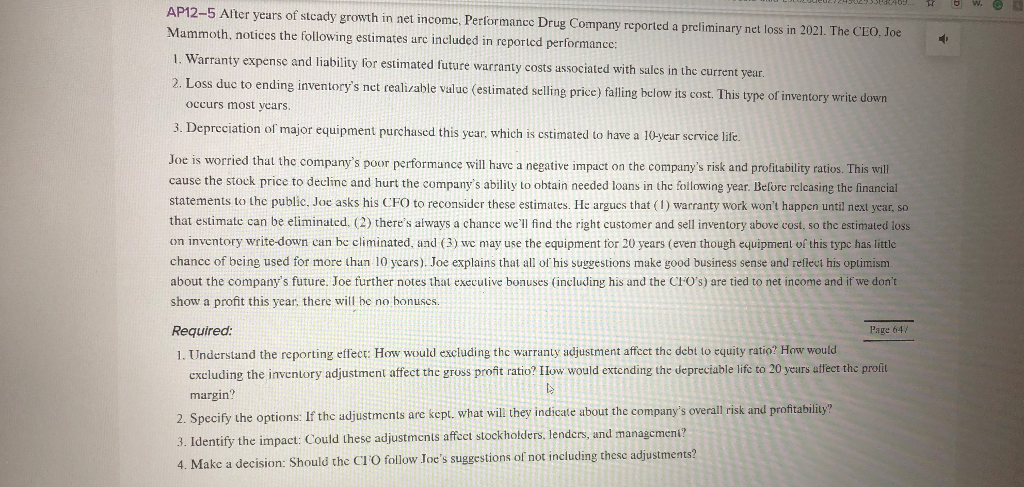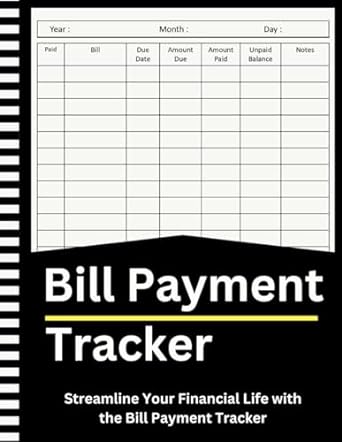1. Roseburg Corporation manufactures cardboard containers. In 2017, the company purchased several large tracts of timber for $20 million with the intention of harvesting its own timber rather than buying timber from outside suppliers. However, in 2021, Roseburg abandoned the idea and sold all of the timber tracts for $30 million. Net income for 2021, before considering this event, was $12 million.
Required:
Write a memo providing your recommended income statement presentation of the gain on the sale of the timber tracts. Be sure to include a discussion of the alternatives that might be considered.
2.
AP12-5 After years of steady growth in net income, Performance Drug Company reported a preliminary net loss in 2021. The CEO. Joe Mammoth, notices the following estimates are included in reported performance: 1. Warranty expense and liability for estimated future warranty costs associated with sales in the current year. 2. Loss due to ending inventory's net realizable valuc (estimated selling price) falling below its cost. This type of inventory write down occurs most years. 3. Depreciation of major equipment purchased this year, which is cstimated to have a 10-year service life. Joe is worried that the company's poor performance will have a negative impact on the company's risk and profitability ratios. This will cause the stock price to decline and hurt the company's ability to obtain needed loans in the following year. Before releasing the financial statements to the public, Joe asks his CFO to reconsider these estimates. He argues that (1) warranty work won't happen until next year, so that estimate can be eliminated, (2) there's always a chance we'll find the right customer and sell inventory above cost, so the estimated loss on inventory write-down can be climinated, and (3) we may use the equipment for 20 years (even though equipment of this type has little chance of being used for more than 10 years). Joe explains that all of his suggestions make good business sense and reflect his optimism about the company's future. Joe further notes that execulive bonuses (including his and the CFO's) are tied to net income and if we don't show a profit this year, there will be no bonuses. Required: Page 647 1. Understand the reporting effect: How would excluding the warranty adjustment affect the debt to equity ratio? How would cxcluding the inventory adjustment affect the gross profit ratio? Ilow would extending the depreciable life to 20 years affect the profit margin? 2. Specify the options: If the adjustments are kept. what will they indicate about the company's overall risk and profitability? 3. Identify the impact: Could these adjustments affect stockholders, lenders, and management? 4. Make a decision: Should the CTO follow Joe's suggestions of not including these adjustments? AP12-5 After years of steady growth in net income, Performance Drug Company reported a preliminary net loss in 2021. The CEO. Joe Mammoth, notices the following estimates are included in reported performance: 1. Warranty expense and liability for estimated future warranty costs associated with sales in the current year. 2. Loss due to ending inventory's net realizable valuc (estimated selling price) falling below its cost. This type of inventory write down occurs most years. 3. Depreciation of major equipment purchased this year, which is cstimated to have a 10-year service life. Joe is worried that the company's poor performance will have a negative impact on the company's risk and profitability ratios. This will cause the stock price to decline and hurt the company's ability to obtain needed loans in the following year. Before releasing the financial statements to the public, Joe asks his CFO to reconsider these estimates. He argues that (1) warranty work won't happen until next year, so that estimate can be eliminated, (2) there's always a chance we'll find the right customer and sell inventory above cost, so the estimated loss on inventory write-down can be climinated, and (3) we may use the equipment for 20 years (even though equipment of this type has little chance of being used for more than 10 years). Joe explains that all of his suggestions make good business sense and reflect his optimism about the company's future. Joe further notes that execulive bonuses (including his and the CFO's) are tied to net income and if we don't show a profit this year, there will be no bonuses. Required: Page 647 1. Understand the reporting effect: How would excluding the warranty adjustment affect the debt to equity ratio? How would cxcluding the inventory adjustment affect the gross profit ratio? Ilow would extending the depreciable life to 20 years affect the profit margin? 2. Specify the options: If the adjustments are kept. what will they indicate about the company's overall risk and profitability? 3. Identify the impact: Could these adjustments affect stockholders, lenders, and management? 4. Make a decision: Should the CTO follow Joe's suggestions of not including these adjustments







